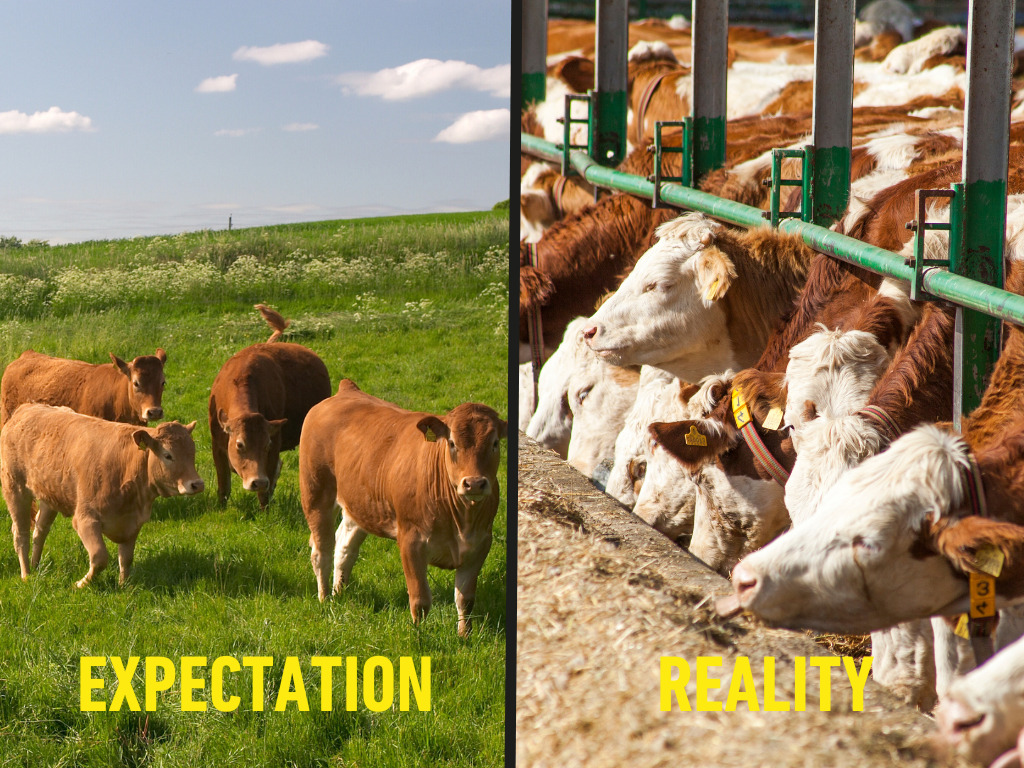100 Billion Animals Are Slaughtered for Meat Every Year – Yet Livestock Farming Doesn’t Get Talked About in Climate Discourse
8 Mins Read
New data shared by Our World in Data shows that approximately 94% of animals on earth live on factory farms and at least 100 billion are slaughtered each year for meat and other animal-derived products. The analysis shows these numbers continue to rise. This is worrying, given livestock farming’s role in exacerbating the climate crisis.
While much of the conversation, marketing and imagery around animal agriculture is dominated by pasture-fed, organic, ‘happy’ animals – the ‘happy cow myth’ perpetuated by the meat and dairy lobby – the reality is that such animals account for a tiny percentage of the world’s total animal population. The rest? According to statistics compiled by Our World in Data‘s Hannah Ritchie, most animals on the planet are factory-farmed and exploited for products used and consumed by humans.
There is no internationally agreed-upon definition of what factory farms are, though in the US they are often referred to as concentrated animal feeding operations (CAFOs). According to the US EPA, an animal feeding operation is one where animals are kept in confined conditions without access to the outdoors for at least 45 days in a 12-month period.
A CAFO has to meet these requirements for a certain number of animals within that confined space. It’s defined as an intensive operation and takes the treatment of wastewater into account. For example, a small CAFO for large animals like cattle would have less than 300 cows or calf pairs, while a large one would have over 1,000.
While cows were slightly more likely to be raised in open areas with more freedom to roam, 70% of them (66 million) were still factory-farmed. Meanwhile, that share rises to 98% for pigs, 71 million of whom are fed in CAFOs.
With chickens – who are much smaller in size, of course – CAFOs range from less than 37,500 birds to over 125,000. The bigger problem is that there’s no defined area for these operations – so it’s hard to characterise just how congested these farms might be.
If these numbers are shocking, here’s a look at the total number of animals raised on factory farms.
The vast majority of land animals are raised on factory farms
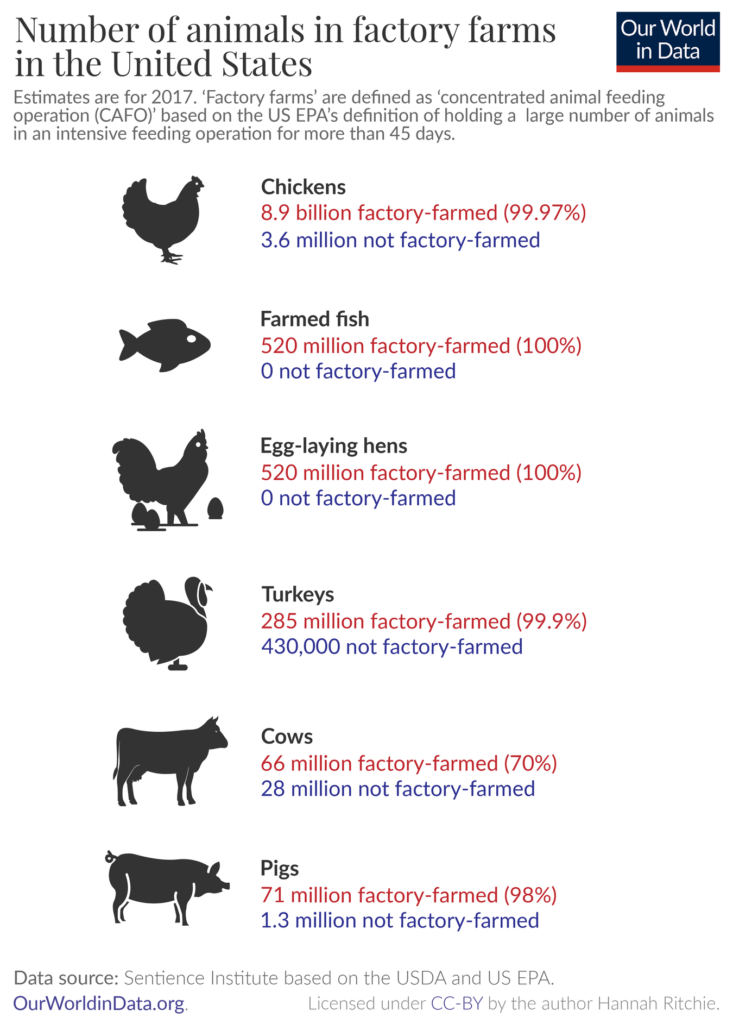
Our World in Data crunched the latest figures from the UN’s Food and Agriculture Organization (FAO) to find that 83.58 billion animals are raised on factory farms across the globe. China tops the list with 16.86 billion, followed by the US (9.73 billion) and Brazil (6.37 billion).
Reviewing separate data from the Sentience Institute, Ritchie found that in 2017, 99% of livestock in the US was factory-farmed. That amounts to 10 billion animals – which is higher than even the current human population. Of these, 8.9 billion were chickens (comprising 99.97% of the total chicken population) farmed for meat and 520 million were egg-laying hens (100% of the total number).
As of 2021, over 73 billion chickens across the globe are slaughtered each year, according to the FAO. Additionally, 4.3 billion ducks, 1.4 billion pigs, 626 million turkeys, 600 million sheep, 495 million goats and nearly 322 million cows and calves are killed annually.
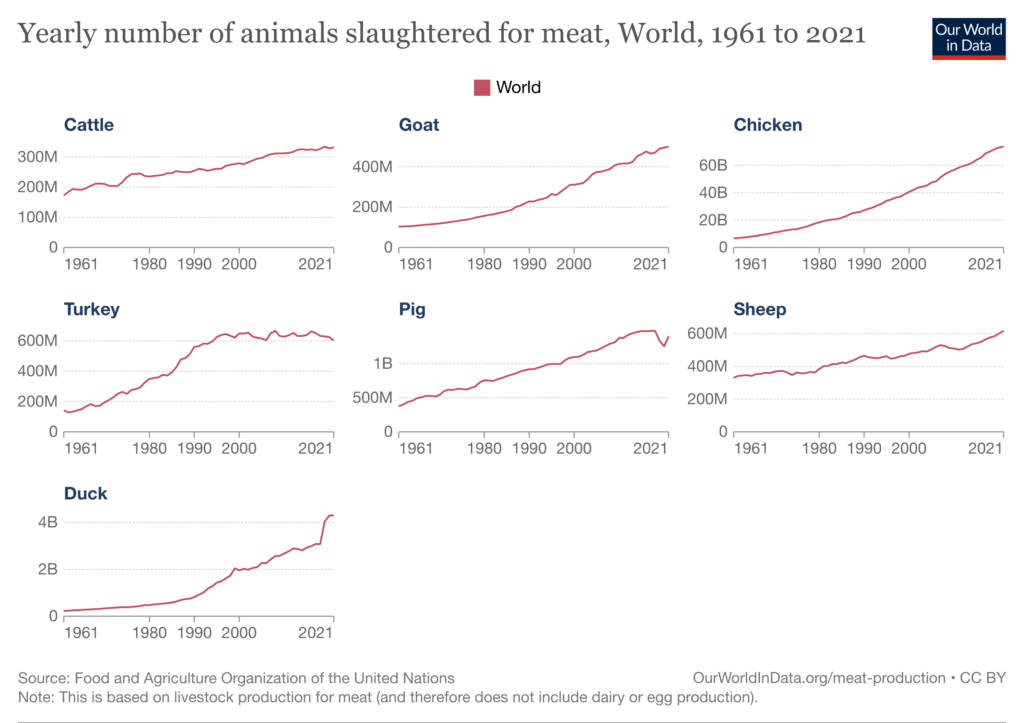
The Sentience data estimates that 74% of land animals are raised and fed on factory farms globally –according to Ritchie, that means 23 billion animals are on these farms at any given point in time.
If you combine land animals and fish, she says the final estimate comes to 94% of animals living in CAFOs. The reasons the US has a higher share of factory-farmed land animals are twofold: “First, the US farms many chickens, and these animals are most likely to be factory-farmed. Second, the US factory farms are particularly efficient (but intensive) in producing as much meat as possible. Other countries will have less intensive systems.”
Therefore, she says, three-quarters of land-based livestock seems like a reasonable estimate when excluding fish.
What about fish?
All fish raised in fish farms were also considered factory-farmed in Ritchie’s data set, with the Sentience Institute noting there is not enough conclusive fish farming data.
The uncertainty around fish is because “global estimates of the number of farmed fish are difficult to find”, explains Ritchie, as these are usually presented in tonnes or kilograms of seafood – not in terms of the number of animals.
She adds: “This point makes clear how little attention is given to animal welfare issues: animals are discussed in terms of tonnage of meat, not as individuals.”
If one assumes most of the industry involves factory farms (there is no pasture-fed equivalent for fish), the total number of fish adds up to 111 billion – as per a Sentience Institute’s estimate, with other figures ranging from 39 to 216 billion. This median figure is “about the same as the number of humans that have ever lived (estimated to be 108 billion)”, Ritchie points out.
The public health costs of factory farming
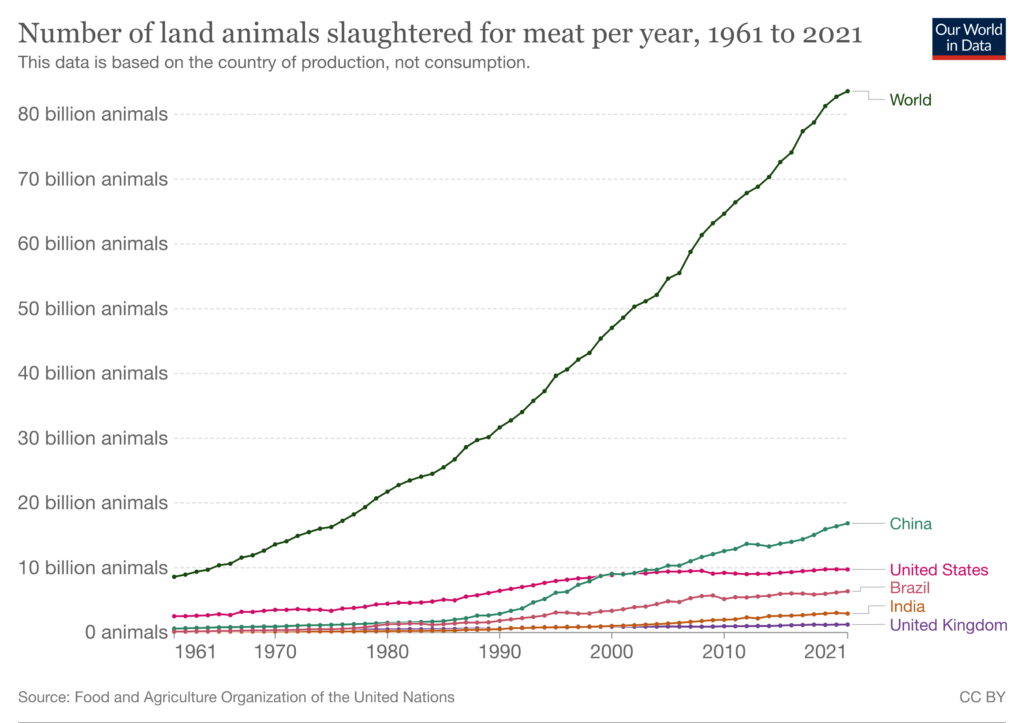
Factory farms have other serious externalities, including public health costs. Water pollution from factory farms threatens or impairs over 14,000 miles of rivers and streams and more than 90,000 acres of lakes and ponds across the US. Nitrogen and phosphorous waste from factory farms has been directly linked with aquatic deaths. On top of that, just 5% of CAFOs generate about 575 billion lbs of animal waste each year, which contains elements that “seriously degrade” rivers and contribute to antibiotic resistance among humans. This has led to the American Public Health Association calling for a ban on new CAFOs.
Indeed, the EPA is currently being sued by a coalition of advocacy groups after it rejected a petition to introduce stricter water pollution regulations in CAFOs. Research has shown that 74% of large US slaughterhouses have violated water pollution permits, and fewer than a third of the nation’s 21,500+ largest CAFOs have federal pollution permits in place.
Factory farming can lead to diseases in animals that can also transfer to humans who consume products made from them. Italy, for example, recently culled tens of thousands of pigs to contain an African swine fever outbreak, a couple of years after China slaughtered more than a billion animals to fight the disease.
Animal welfare laws lose some steam
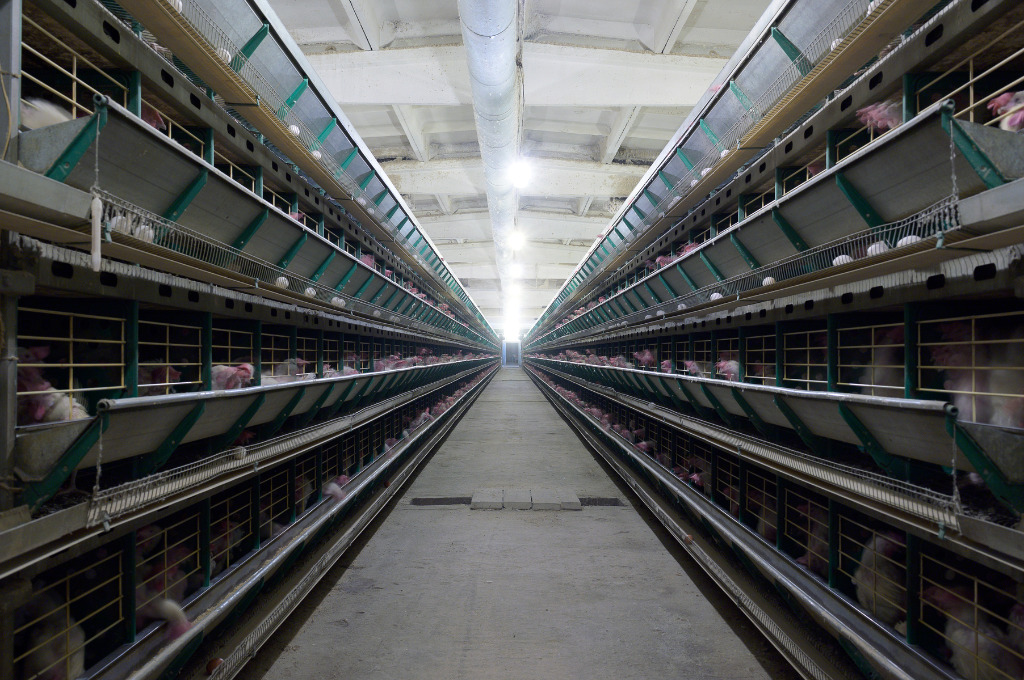
Animal welfare laws appear to be weakening, thanks to successful lobbying from the meat industry.
While US activists achieved a breakthrough earlier this year with the Supreme Court’s ruling on Prop 12 – which bans the sale of meat from pigs kept in gestation crates–- despite aggressive lobbying against it by the country’s pork industry, the law is currently limited to California and it is doubtful that a federal version would ever be endorsed.
One organisation holding administrators and stakeholders to account is US-based Farmstand, which describes itself as the “only legal group in the country dedicated solely to taking on Big Ag”. The group of lawyers has previously forced factory farms in Washington to clean up polluted groundwater, and is now helping farm workers sue the Colorado Livestock Association’s attempt to thwart their right to essential services.
Meanwhile, in the UK, which formally recognised animals as sentient in 2021, proposals for mandatory animal welfare labelling based on pork and pig products were dropped a few weeks ago, months after plans for legislation to ban live exports of farm animals were scrapped. This is despite support from the public to introduce improved labelling.
Earlier this month, in another disappointing reversal for animal welfare, France’s agriculture minister endorsed factory farming and urged farmers to produce cheaper and higher amounts of meat. Yesterday, French President Emmanuel Macron was widely hailed for unveiling what he termed an “ecological plan” to reduce the country’s emissions by 55% by 2030. The initiative focuses on abolishing fossil fuel use, with no mention of, or focus on, animal agriculture.
The EU’s animal welfare resolve shows signs of faltering too. In early September, the Financial Times reported that the European Commission was considering dropping its landmark cage-free farming legislation that would have phased out cages for 300 million farmed pigs, egg-laying hens, rabbits, and other species. While a spokesperson denied this was the case to Vox, aggressive lobbying from industry players appears to have cast some doubt on the standard’s future.
Consumers are divided on this issue, too. While an EU Barometer survey showed that 94% of respondents agreed with the statement that “it is important to protect the welfare of farmed animals” and 59% said they were willing to pay more for animal-welfare-endorsed products, 63% of Swiss citizens recently voted against a ban on intensive livestock farming and a boost for animal welfare rules.
The lack of animal agriculture in climate discourse
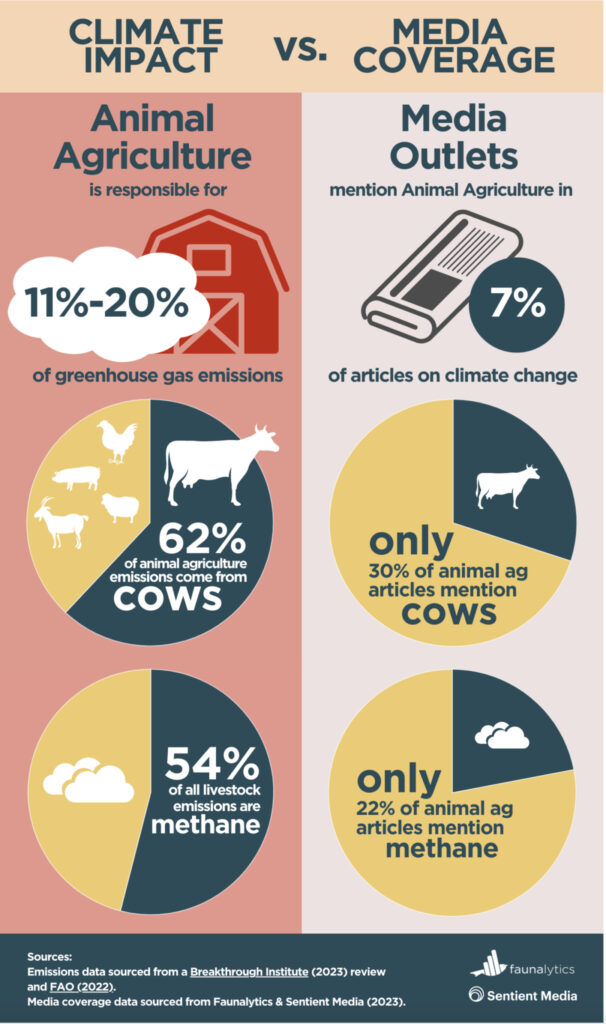
Factory-farmed animals are more than just an animal welfare issue. Despite livestock farming being found to produce between 11-19.5% of the planet’s overall emissions, there is a notable lack of mainstream media coverage about the link between industrial animal agriculture and the climate crisis.
One study has found that 93% of all climate coverage by the media doesn’t even mention livestock farming –and the reporting that does mention it portrays the livestock farming sector as a victim, rather than a cause, of climate change.
Meat accounts for nearly 60% of all emissions from food, while animal-derived foods cause twice as many emissions as plant-based foods. Additionally, vegan diets can reduce emissions, water pollution and land use by 75% compared to meat-rich diets. A study published earlier this month has found that replacing animal products with plant-based alternatives – and reforesting the land spared from livestock farming – could double climate benefits by 2050.
Despite the global scientific consensus around reducing meat to fight rising global greenhouse gas emissions, the average consumer remains unaware of the issue. A July Washington Post poll found that 74% of Americans believe cutting out meat has no impact on climate change, and 77% feel the same about dairy consumption.
Given the urgency needed to address climate change, factory farms (and reducing the number of farmed animals) need to become a key priority for governments, the media and the public discourse.
With additional research by Sonalie Figueiras.


